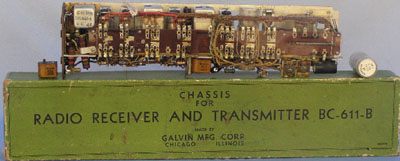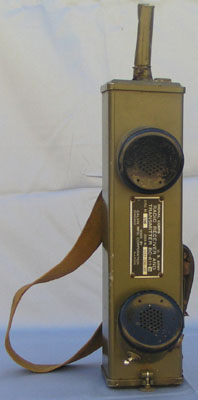Illustrations of the set



The set was designed to be used in the left hand, although either could be used. It was specifically designed to resemble a hand telephone.
The set is extemely easy to operate. To turn the set on, all one has to do is pull out the antenna, which triggers the on/off switch. The press to talk button is the only other control, the volume being pre-set and unalterable by the operator.
The operating distances were between 100 feet and 1 mile. Better results appear to have been obtained on the lower frequencies when difficult paths had to be crossed.
The set was powered by dry batteries, the "A" filament battery BA-37 being 1.5v and the "B" battery (H.T.) being 103.5v. The batteries were designed to last 15 hours under almost continuous operations.
The current drain is as follows:
Receive "A" 250ma "B" 11ma
Transmit "A" 304ma "B" 35ma
The frequency coverage was between 3500 kc to 6000 kc. The sets were crystal locked on one of 50 design frequencies. Two crystals were required - one for transmit and one for receive.
The sets were quite popular after the war, but became effectively useless when the batteries became unprocurable.
The crystals were a different matter - they became quite popular and were available in their thousands. They were of the FT 243 type, and for this set were available in 100 different frequencies. Because they were able to be opened and reassembled, crystal grinding became a popular pastime. Many crystals around 5.5 mc/s ended up in crystal filters!


© Ian O'Toole, 2009. Page created: 28/04/03 Last updated: 4/12/2009